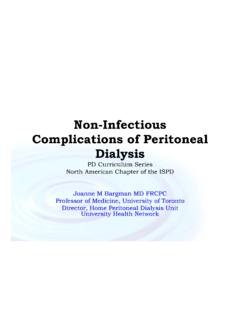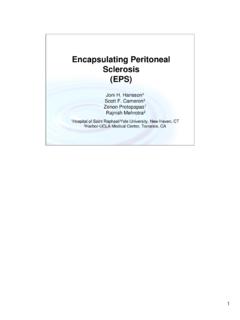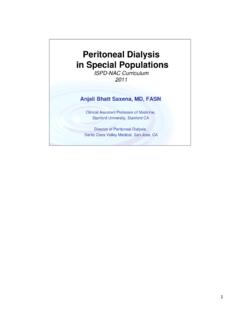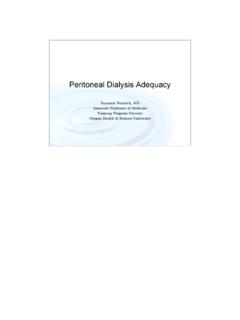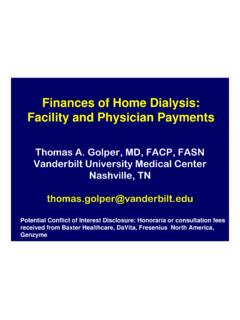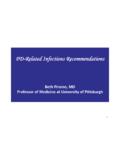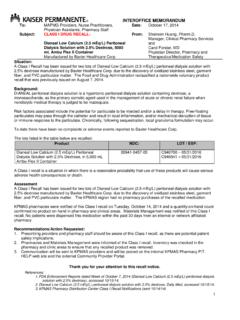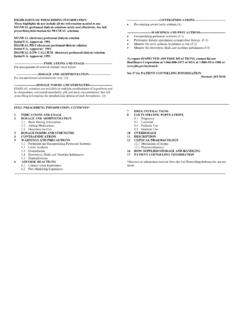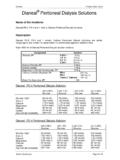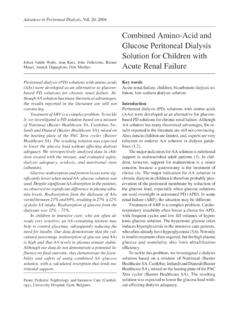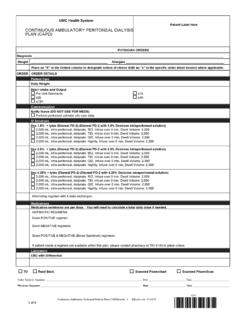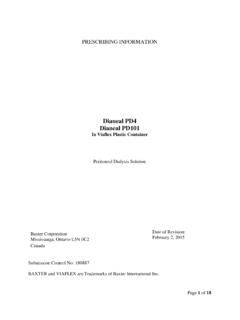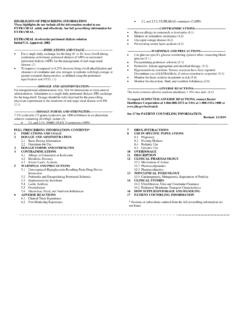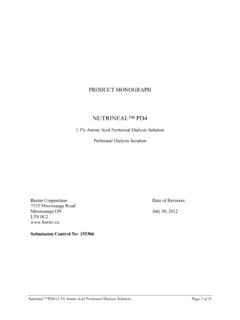Transcription of Peritoneal Dialysis Prescription and Modalities
1 1 Peritoneal Dialysis Prescription Peritoneal Dialysis Prescription and Modalitiesand ModalitiesMaria V. DeVita, Director Nephrology Lenox Hill Hospital Clinical Associate Professor of Medicine NYU School of MedicineMeghana Gaiki, , Division of Nephrology, Lenox Hill HospitalEmmanuelle Gilles, , Division of Nephrology, Lenox Hill HospitalGoals and Objectives Introduction to the different Modalities of Peritoneal Dialysis (PD). Clinical implication of Peritoneal Equilibration Test (PET). Chronic Peritoneal Dialysis Prescription . Automated versus Ambulatory Peritoneal Dialysis in terms of Mortality Technique survival Impact on Residual Renal Function(RRF) Volume and blood pressure control3 Continuous Ambulatory Continuous Ambulatory Peritoneal DialysisPeritoneal Dialysis In 1976, In 1976, PopovichPopovichet al introduced the concept of et al introduced the concept of continuous ambulatory Peritoneal ambulatory Peritoneal Dialysis .
2 In 1978, Oreopoulos et al introduced Dialysis solutions in In 1978, Oreopoulos et al introduced Dialysis solutions in plastic bags and use of a single administration tubing for plastic bags and use of a single administration tubing for one week. one week. In 1980, In 1980, BuoncristianiBuoncristianiet al introduced the et al introduced the Y Y Now, continuous Peritoneal Dialysis includes continuous Now, continuous Peritoneal Dialysis includes continuous ambulatory and cyclic Peritoneal Dialysis (CAPD and ambulatory and cyclic Peritoneal Dialysis (CAPD and CCPD)CCPD)Two litres of standard hypertonic dialysate fluid are infused peritoneally and allowed to equilibrate for five hours while the patient conducts his normal high Peritoneal infection rate due to frequent openings in the dialysate delivery circuit and technical burden were the major new approach decreased the number of daily connections and disconnections- and limited the peritonitis Peritoneal DialysisAutomated Peritoneal DialysisBrenner and Rector's The Kidney, 8th edition, 2008 Brenner and Rector's The Kidney, 8th edition, 2008 APD uses a cycler/machine to perform the exchanges.
3 APD uses a cycler/machine to perform the exchanges. For chronic renal failure, APD is traditionally divided intoFor chronic renal failure, APD is traditionally divided into-- Continuous cycling Peritoneal Dialysis /CCPDC ontinuous cycling Peritoneal Dialysis /CCPD Nocturnal intermittent Peritoneal Dialysis / intermittent Peritoneal Dialysis / NIPD. Tidal Peritoneal Dialysis / TPDT idal Peritoneal Dialysis / TPD Hybrid Systems.(exchanges done by the machine at night time and the pt carries the PD solution in the cavity all day)- CCPD(exchanges done by the machine at night time and the pt remains dry all day.)- NIPDAPD has greatly increased in popularity in the past decade and is now used more than CAPD in the United States. Its appeal is that it frees up the daytime from PD procedures for patients and their caregivers. It also has the capacity to deliver more clearance and remove more fluid. 56 The First CyclersThe First Cyclers1962- Developed by BoenThe first automated Peritoneal delivery Boen, Mion, Curtis and G.
4 Shilipetar developed an automated device to do Peritoneal Dialysis at home. It utilized a 40-liter bottle that was filled and sterilized at the University of Washington. The bottles were delivered to the patient's home and returned to the hospital after cam cycler timer was used to meter the Peritoneal fluid into and out of the Peritoneal cavity. A heater plate heated the solution to body temperature and the effluent from the peritoneum was Boen, MD, used the "repeated puncture" method for access. This required that a physician go to the patient's home and surgically place a 14F trocar in the patient's abdomen. The patient's helper would be trained to remove the trocar after the Peritoneal Dialysis ST, Mion CM, Curtis FK, Shilipetar G. Periodic Peritoneal Dialysis using the repeated puncture technique and an automatic cycling machine. Trans Am Soc Artif Intern Organs. 196; 10: 1966 lasker introduced a simple gravity fed cycler. This device used sterile dialysate in 2 l glass bottles, plastic tubing for delivery and a plastic bag for collection of was the forerunner of all modern cyclers.
5 This system could deliver variable amout of warm New CyclersThe New CyclersAutomated PD s recent popularity also reflects the improved technology and design of modern cyclers, which are more compact, light, portable, reliable, and easier to operate than previous cyclers now use hydraulic pumps rather than gravity to deliver and drain the PD solution. They have the facility to do tidal PD which involves deliberately allowing an incomplete drain of a proportion of the infused fluid ( , 50% or 80%) before refilling with the next cycle. This can be used to minimize down time with a poorly draining catheter or to avoid drain pain. Cyclers also allow the daytime solution to be delivered before disconnection and can be used for additional daytime exchanges in an approach that decreases cost and may increase convenience,compared with doing those exchanges with CAPD New CyclersThe New Cyclers9 Modalities of PDModalities of PDBrenner and Rector's The Kidney, 8th edition, 2008 Brenner and Rector's The Kidney, 8th edition, 2008 Continuous cycled Peritoneal Dialysis -3 to 7 cycles of to L delivered over 9 hours at times range from 45 minutes to 3 left in at the end of the cycling period and drained out again before the next cycling period about 15 hours later.
6 Nocturnal intermittent Peritoneal Dialysis or day dry APD No day dwell because of good residual renal function or mechanical contraindications. High-dose APD or PD plus or APD with 2 day dwells more than one day dwell, requires another exchange sometime during the day. APD with short day dwell- leaves some of the day time dry to facilitate ultrafiltration or for comfort or mechanical reasons. Tidal PD- Incomplete drain of a proportion of the infused fluid before refilling with the next cycle. Used to minimize down time with a poorly draining catheter or to avoid drain pain. 10 Interpretation of the PET testInterpretation of the PET test High transport implies a structural or High transport implies a structural or functional alteration of the peritoneumfunctional alteration of the peritoneum-- A larger effective Peritoneal surface A larger effective Peritoneal surface area area AAhigher intrinsic membrane higher intrinsic membrane permeability (for the rapid equilibration permeability (for the rapid equilibration of small solutes including creatinine of small solutes including creatinine and urea).)
7 And urea). High transportersare prone to lose the osmotic gradient required for sustained ultrafiltration because of rapid absorption of glucose from the dialysate. Subsequent decrease in ultrafiltration capacity Tendency to have greater systemic exposure to glucose than low transporters do. FigureFigure--Time-dependent changes during Peritoneal Dialysis in dialysate (D) concentration of glucose (left panel) or creatinine (right panel) as a proportion of original dialysate glucose concentration (DO) or plasma creatinine concentration (P), respectively. The absorption of glucose from the dialysate gradually lowers the D/DO ratio, while the diffusion of creatinine into the dialysate raises the D/P ratio. Slow transporters may be inadequately dialyzed due to diminished solute removal. Rapid transporters can achieve a D/P creatinine ratio above and a D/DO glucose below at four hours; they may be predisposed to malnutrition from increased amino acid losses in the dialysate and to decreased fluid removal due to absorption of glucose.
8 Data from Twardowski, TJ, Blood Purif 1988; 7 who are Patients who are rapid transportersrapid transporterstend to equilibrate small solute concentrations between dialysatend to equilibrate small solute concentrations between dialysate and blood te and blood early in a dwell time. early in a dwell time. These patients also readily absorb glucose from the dialysate. OThese patients also readily absorb glucose from the dialysate. Once the osmotic gradient is dissipated, ultrafiltration nce the osmotic gradient is dissipated, ultrafiltration 11 Clinical implications of Clinical implications of transporter typetransporter type High transporters tend to have problems High transporters tend to have problems achieving ultrafiltration goals but are efficient achieving ultrafiltration goals but are efficient with clearance. Low transporters tend to achieve ultrafiltration Low transporters tend to achieve ultrafiltration goals but have difficulty with clearance targets.
9 Goals but have difficulty with clearance targets. Traditionally, high transporters were thought to Traditionally, high transporters were thought to do best on regimens that involve frequent short do best on regimens that involve frequent short duration dwells (APD) maximizing ultrafiltration, duration dwells (APD) maximizing ultrafiltration, and low transporters needed longer dwell times and low transporters needed longer dwell times (CAPD) to maximize clearances.(CAPD) to maximize PD Regimens Required to Achieve Adequate Solute ClearancesPeritoneal Solute Transport Characteristics D/P Creatinine at 4 HoursPatient BodySurface Area (m2)Low(< )Low Average( to < )High Average( )High(> )< litersCAPD/APD+10 litersAPD+*10 litersAPD*10 + 15 litersAPD+ 15 litersAPD+* 15 litersAPD+* 15 liters> +,HDAPD+15 20 litersAPD+*15 20 litersAPD+*15 20 litersAdapted From Comprehensive Clinical NephrologyComprehensive Clinical Nephrology--John John FeehallyFeehally, , JurgenJurgenFloegeFloege, Richard , Richard J.
10 Johnson, 3J. Johnson, 3rdrdedition, , 2007.+ + an additional exchange , * use of icodextrin solution .These are the typical PD regimens used to achieve adequate solute clearance according to patient size and membrane characteristics in anuric patients. The total volume of dialysate fluid required increases with body size ( to 3 L/ exchange). APD using shorter overnight dwells is favored over CAPD, as solute transport increases. Both CAPD and APD may have to be augmented by use of an additional exchange ( for increased solute clearances or UF respectively). The use of icodextrin solution for the long exchange will enhance both solute clearance and Dialysis PrescriptionHandbook of Dialysis , fourth edition, 2006, John T. Daugirdas, Peter G. Blake, Todd S. Ing Clearance Targets-A consensus target Kt/V for all Modalities of PD is per week. KDOQI guidelines suggest that Peritoneal and renal Kt/V can be added to achieve the residual renal function has repeatedly been shown to be associated with superior survival.

